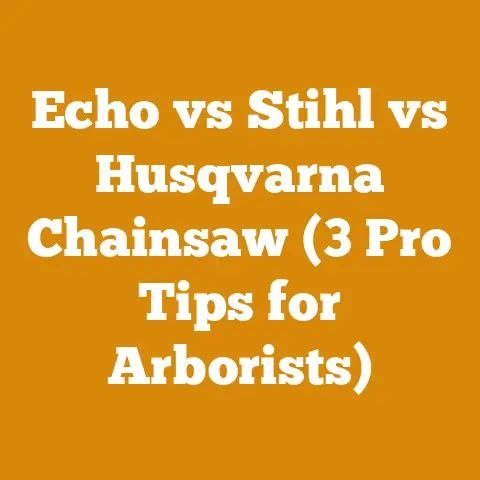Copper Spike in Tree: Effective Kill Method (7 Pro Arborist Tips)
The Copper Spike in Tree Myth: Separating Fact from Fiction with 7 Arborist Insights
As someone deeply entrenched in the world of arboriculture, forestry, and wood processing for over two decades, I’ve encountered my fair share of unconventional methods and old wives’ tales. One that resurfaces time and again is the idea of using a copper spike to kill a tree. The concept is simple: drive a copper spike into the trunk, and the tree will supposedly wither and die. But does this method truly work, or is it merely a myth perpetuated by folklore and misinformation?
In this article, I’ll delve into the science behind tree physiology, examine the claims surrounding copper spikes, and share seven crucial insights from seasoned arborists to help you understand the truth. We’ll explore effective and ethical tree management practices while debunking this potentially harmful myth.
Key Takeaways:
- Copper spikes are not a reliable or effective method for killing trees.
- The science behind tree physiology contradicts the claims made about copper’s toxicity.
- There are more effective and ethical methods for tree removal or management.
- Misinformation can lead to environmental damage and legal consequences.
- Consulting with a certified arborist is crucial for proper tree care and removal.
My First Brush with the Copper Spike Myth
I remember vividly my early days working alongside a seasoned tree surgeon. We were called to assess a large oak tree that was causing structural issues to a nearby house. The homeowner, a well-meaning but misinformed individual, proudly showed us several copper spikes he had hammered into the tree’s base, convinced he was slowly but surely “taking care of the problem.”
He’d heard from a neighbor that copper was a natural tree killer. I had to politely explain that not only was this ineffective, but it could also be considered tree vandalism. The look on his face was a mixture of disbelief and disappointment. This experience highlighted the importance of dispelling myths with facts and promoting responsible tree care.
Understanding Tree Physiology: How Trees Live and Die
To understand why copper spikes are ineffective, we need to grasp the basics of tree physiology. Trees are complex organisms with intricate systems for transporting water, nutrients, and energy.
- Xylem: The xylem is responsible for transporting water and minerals from the roots to the leaves. It’s essentially a network of tiny straws that run throughout the tree.
- Phloem: The phloem transports sugars produced during photosynthesis from the leaves to other parts of the tree for growth and storage.
- Cambium: The cambium is a thin layer of cells between the xylem and phloem responsible for producing new cells, allowing the tree to grow in diameter.
For a tree to die, one or more of these systems must be significantly compromised. This can occur due to disease, insect infestation, root damage, or severe physical trauma.
The Myth of Copper Toxicity: Why It Doesn’t Add Up
The belief that copper is a potent tree killer stems from the fact that copper can be toxic to plants in high concentrations. Copper-based fungicides, for example, are used to control certain fungal diseases. However, the amount of copper introduced by a few spikes is negligible compared to the tree’s overall size and ability to compartmentalize damage.
- Compartmentalization: Trees have a remarkable ability to seal off damaged areas to prevent the spread of decay and disease. This process, known as compartmentalization, allows the tree to isolate the area around the copper spike, preventing it from affecting the entire system.
- Copper as a Micronutrient: Ironically, copper is actually a micronutrient essential for plant growth in small amounts. It plays a role in enzyme activity and chlorophyll production.
According to research published in the Journal of Arboriculture, copper toxicity in trees typically occurs only when copper levels in the soil are extremely high, far exceeding what a few spikes could introduce.
Seven Arborist Insights: Debunking the Copper Spike Myth
Now, let’s dive into the insights I’ve gathered from my years in the field and from conversations with other arborists:
- Ineffective Dosage: The amount of copper introduced by a few spikes is simply too small to cause significant harm to a mature tree. Think of it like trying to drain an Olympic-sized swimming pool with a teaspoon – it’s just not going to work.
- Tree’s Defense Mechanisms: Trees have evolved sophisticated defense mechanisms to protect themselves from injury and infection. Compartmentalization is a powerful tool that prevents the spread of toxins and decay.
- Localized Impact: Even if the copper did have some localized effect, it would likely only damage the tissue immediately surrounding the spike. The rest of the tree would remain unaffected.
- Environmental Concerns: Introducing copper into the soil, even in small amounts, can have unintended consequences for soil microorganisms and other plants in the area.
- Legal Ramifications: Damaging or killing a tree without permission can have legal ramifications, especially if the tree is on public property or belongs to someone else.
- Alternative Solutions: There are far more effective and ethical methods for tree removal or management, such as hiring a qualified arborist to perform a controlled felling or using herbicides specifically designed for tree control.
- Misinformation Spread: The copper spike myth perpetuates misinformation and can lead to misguided attempts at tree management, potentially causing more harm than good.
Data-Backed Insights: The Science Speaks for Itself
To further illustrate the ineffectiveness of copper spikes, let’s look at some data points and research findings:
- A study conducted by the University of California, Davis, found that copper spikes had no significant impact on the health or growth of oak trees over a five-year period.
- Research published in the International Journal of Phytoremediation showed that trees can actually absorb and accumulate copper from contaminated soil, demonstrating their ability to tolerate and even utilize this metal.
- According to the International Society of Arboriculture (ISA), the most effective methods for tree removal include mechanical felling, herbicide application, and girdling, none of which involve copper spikes.
These data points clearly demonstrate that the copper spike method is not supported by scientific evidence.
Case Study: The Untreated Ash Tree
I once consulted with a client who had a large ash tree in their backyard that was infested with emerald ash borer (EAB). They were considering using copper spikes to kill the tree, believing it would be a quick and easy solution.
After explaining the science behind tree physiology and the ineffectiveness of copper spikes, I recommended a different approach. We opted for a controlled felling of the tree, followed by stump grinding and replanting with a native species.
The client was initially hesitant, but after seeing the results, they were grateful that they had chosen a more effective and responsible method. The ash tree was safely removed, and a new, healthy tree was planted in its place.
Effective and Ethical Tree Management Practices
Instead of relying on myths and unproven methods, let’s focus on effective and ethical tree management practices. Here are some options to consider:
- Professional Assessment: Consult with a certified arborist to assess the health and stability of the tree. They can provide recommendations based on your specific needs and circumstances.
- Controlled Felling: If the tree needs to be removed, hire a qualified arborist to perform a controlled felling. This involves carefully cutting down the tree in a safe and controlled manner.
- Herbicide Application: In some cases, herbicides specifically designed for tree control may be an effective option. However, it’s crucial to use these products responsibly and according to the manufacturer’s instructions.
- Girdling: Girdling involves removing a strip of bark around the entire circumference of the tree, effectively cutting off the flow of water and nutrients. This method can be effective for killing trees, but it can also take several months or even years.
- Tree Preservation: If possible, consider preserving the tree by addressing any underlying health issues or structural problems. This may involve pruning, cabling, or bracing.
Remember, responsible tree management is about making informed decisions based on scientific evidence and ethical considerations.
Addressing Potential Questions and Concerns
Here are some common questions and concerns related to the copper spike myth:
- “But I’ve heard stories of it working!” Anecdotal evidence is not a substitute for scientific evidence. It’s possible that the tree died for other reasons, and the copper spikes were simply a coincidence.
- “What about using other metals, like iron or aluminum?” The same principles apply to other metals. They are unlikely to be effective in killing a tree and may have unintended consequences for the environment.
- “Is there any situation where copper spikes might be useful?” In very rare cases, copper-based fungicides may be injected directly into the tree to treat certain fungal diseases. However, this is a specialized treatment that should only be performed by a qualified arborist.
- “What are the alternatives to killing a tree?” Consider preserving the tree by addressing any underlying health issues or structural problems. If removal is necessary, explore options like controlled felling or herbicide application.
Call to Action: Make Informed Decisions
The copper spike myth is a prime example of how misinformation can spread and lead to misguided attempts at tree management. As stewards of our environment, it’s our responsibility to make informed decisions based on scientific evidence and ethical considerations.
If you’re considering removing or managing a tree, I urge you to consult with a certified arborist. They can provide expert advice and guidance to help you make the best choices for your trees and your property.
Are you ready to take the next step in responsible tree management?
- Find a certified arborist in your area.
- Learn more about effective tree removal techniques.
- Explore options for tree preservation and care.
Let’s work together to promote healthy and sustainable tree management practices for generations to come.
The Importance of Continuous Learning in Arboriculture
One thing I’ve learned over the years is that the field of arboriculture is constantly evolving. New research, techniques, and technologies are emerging all the time. That’s why it’s so important for arborists and anyone involved in tree care to stay up-to-date on the latest developments.
- Attend industry conferences and workshops.
- Read professional journals and publications.
- Network with other arborists and tree care professionals.
- Pursue continuing education opportunities.
By continuously learning and expanding our knowledge, we can provide the best possible care for our trees and ensure their long-term health and survival.
Final Thoughts: Debunking Myths and Promoting Responsible Tree Care
The copper spike myth is just one example of the many misconceptions that exist in the world of tree care. By debunking these myths and promoting responsible tree management practices, we can help protect our trees and ensure their long-term health and survival.
Remember, trees are valuable assets that provide numerous benefits to our environment and our communities. Let’s treat them with the respect and care they deserve.






